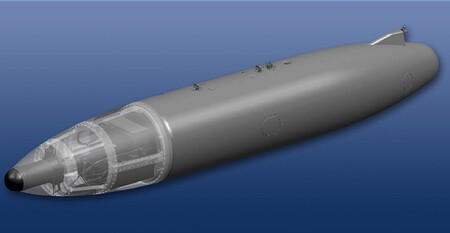There are more modern, more expensive, newer fighters. The F-35, for example, with its futuristic cabin and its advanced stealth. Or the F-22 Raptor, less young, but so well known that you barely need a presentation. Even the future F-47. But while that happens, a good part of the United States aerial muscle continues to rest on the shoulders of a veteran: the F/A-18E/F Super Hornet. A plane that began to fly in 1995 and that, with constant updates, it is still the versatile hunting par excellence of the Navy. The challenge is to keep it up. And for that, added added.
One of them is the Irst Block II, a infrared search and monitoring system designed by Lockheed Martin. It is integrated into a modified central deposit and costs, according to the latest GAO report, 16.6 million dollars per unit. Its function is to detect threats from long distances without the need to turn on the radar, which allows the pilot to “see without being seen.” A key tool against poachers, long -range drones and environments with intense electronic warfare.
In theory, a tactical jump. In practice, for the moment, a problem
While IrST Block II has already been tested in real operations, and its capabilities are well documented, it has a serious obstacle: reliability. According to the same GAO report, the system fails, on average, Every 14 hours of flight. The minimum required by the Navy is 40. That is, the sensor does not endure even half of the time that should suffer a critical failure. And this is making its large -scale deployment difficult.
During the operational tests carried out between April and September 2024, the IRST Block II showed unstable behavior. According to a DOT & E report, the system suffered unexpected reinstatements in full flight, software blockages and hardware failures that, in many cases, required direct assistance of engineers from Lockheed Martin. The marine maintenance crew could not solve them alone.

The failures are not limited to software. In 2023, a previous GAO report warned that between 20 % and 30 % of the manufactured components did not comply with the technical specifications. They identified themselves Microelectronics problemsthe cooling system and the general assembly of the Pod. Although some of these deficiencies have been corrected, but many others persist, as we have just seen above.


The schedule of the program has been deteriorating year after year. The decision to go to production in full cadence was scheduled for early 2025, but was postponed. And that has consequences. The Irst Block II is not just a punctual improvement: it is an essential piece within the effort to keep the Super Hornet competitive against more modern rivals such as China and Russia.

The ironic thing is that while the navy still hopes to trust its star sensor, the American Air Force has already integrated similar systems in its F-15 y F-16. In Western Europe, Eurofighter Typhoon also incorporates a similar solution. Apparently, operating from an aircraft carrier implies other conditions, and that is complicating things for the US Navy.
United States Marina | Dot & e | LOCKHEED MARTIN
In WorldOfSoftware | We prepare to say goodbye to Windows 10, but part of the US Air Control still works with disks and Windows 95











